 Trekking on the Salkantay trail.
Trekking on the Salkantay trail.The Classic 4-day Inca Trail trek leading to Machu Picchu’s Sun Gate is one of the most popular hikes in the world. However, there are six phenomenal Inca Trail alternatives to consider adding to your Peru trip .
Since 2001, the Peruvian government has enforced strict rules to preserve the ancient Inca Trail. Each February the trek is closed for maintenance, and every other day of the year there are only a total of 500 daily permits available (200 for trekkers, and 300 for trekking staff). As a result, visitors planning to hike the Inca Trail often find that the permits are sold out several months in advance due to limited availability and high demand.
If you hit this brick wall or if you just prefer trekking off the beaten path , there are a variety of Inca Trail alternatives to choose from. While they may not enter Machu Picchu through the Sun Gate, w hichever trek you choose, you are guaranteed an unforgettable experience in the Inca heartland.
Last updated by Melissa Dreffs in July 2020.
The Salkantay Trek is the most popular Inca Trail alternative trek for those wanting a Machu Picchu tour along with the trek. This trail follows a portion of the of the Qhapaq Ñan , the ancient transportation network built by the Incas. It climbs through the mountains, gradually increasing in elevation until reaching the Salkantay Pass. From there, the trek descends towards Machu Picchu and the jungle.
| Salkantay Trek | Inca Trail | |
| Duration and distance | 5 days, 32 miles | 4 days, 30 miles |
| Advance permit required | No | Yes, 4-day Inca Trail permit must be secured in advance |
| Arriving to Machu Picchu | By bus to the main entrance | On foot through the Sun Gate |
| Nights camping or in hotels | 3 nights camping, 1 night in a hotel | All 3 nights camping |
| Porters | Pack animals can help carry personal belongings through Day 4. | Personal porters can be hired ahead of time. No pack animals are allowed on the Inca Trail. |
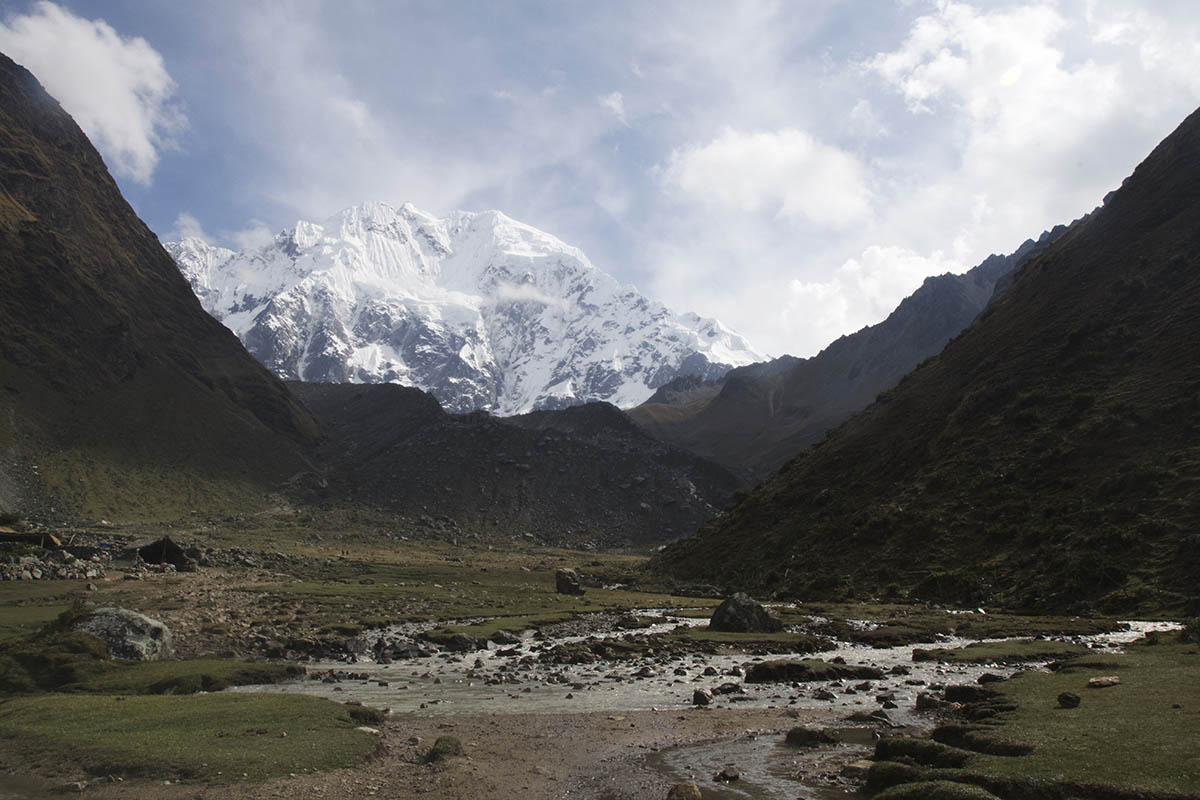
Hiking along the Salkantay trail. Photo by Rachel Walker of Peru for Less.
From Cusco , trekkers will take a car to Mollepata, where the Salkantay trail begins. Visitors will hike through the Rio Blanco Valley, making their way to their first campsite at Soray Pampa. The first day ends with breathtaking views of the snow-capped Salkantay and Humantay Mountains.
Optional: A branch-off hike to Lake Humantay is possible, weather permitting, in the afternoon.
The second day of hiking is the longest and most challenging, going from one extreme terrain to another. Trekkers journey past the rugged Salkantay Pass before descending along the Salkantay River. Warmer, lush forests at lower elevations await. This is the toughest day of the hike, but by far the most beautiful. With stunning views of the Vilcanota range and the unique subtropical microclimate of the valley below, this leg of the trek will offer plenty of opportunities for magnificent pictures.
Continuing the journey, the trail snakes its way along the Santa Teresa River to arrive in a small village of the same name. In this high-jungle area, trekkers will pass by coffee, tea, bamboo, avocado, and granadilla farms. Trekkers will also have an opportunity to interact with the local farmers for a remarkable cultural experience.
Optional: A visit to the Santa Teresa hot springs is possible, weather permitting, in the afternoon.
Day four begins with a gradual ascent to the archeological site, Llactapata. From this site, trekkers get their first glimpse of Machu Picchu from afar. After visiting Llactapata, trekkers finish the last leg of the Salkantay trail, ending in Hidroelectrica. From there, hop on the train to Aguas Calientes , the small village nestled at the base of Machu Picchu Mountain.
After a good night’s rest in a Machu Picchu hotel , trekkers make their way up to the Machu Picchu citadel. Hike Machu Picchu Mountain or its more grandiose neighbor, Huayna Picchu , for the best aerial views of the Lost City. Following the hike, trekkers will take a guided tour of Machu Picchu before heading back to Cusco by train.
Permits to hike Machu Picchu Mountain and Huayna Picchu are limited and must be secured in advance.
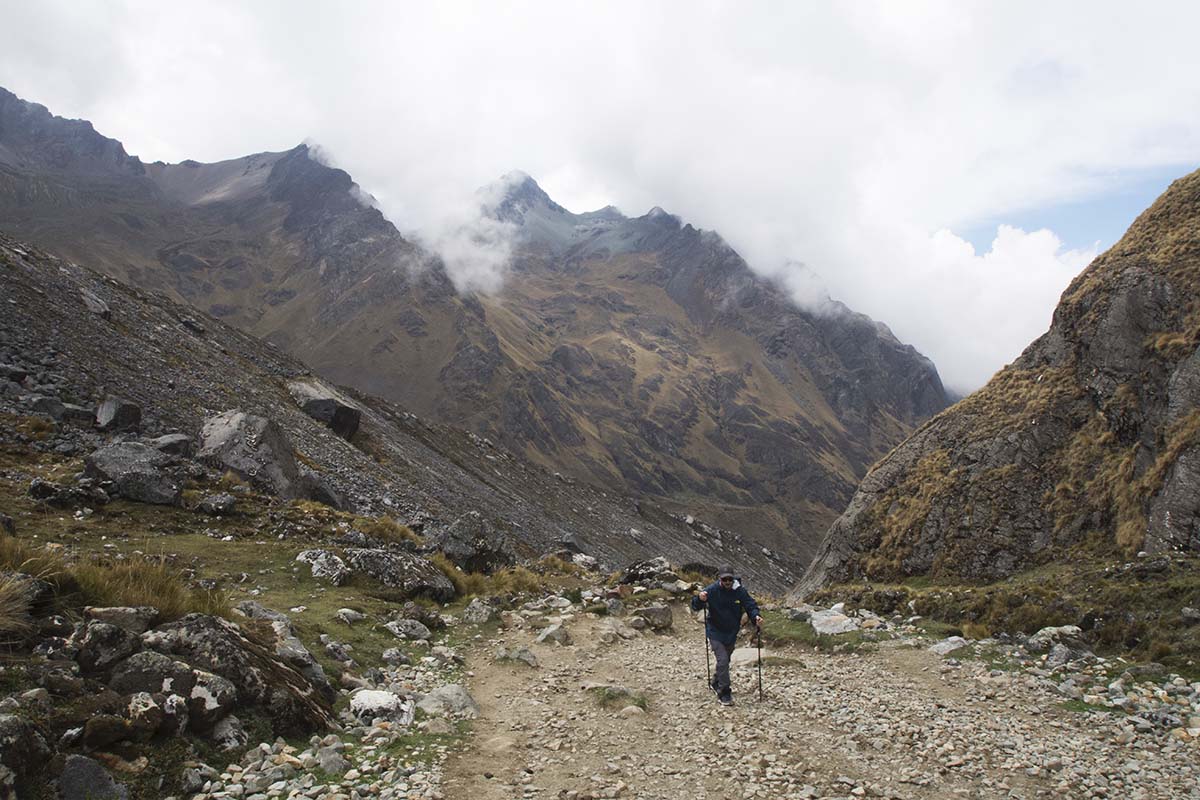
Hiker on the Salkantay trail. Photo by Rachel Walker of Peru for Less.
The Lares Trek to Machu Picchu, known as the “weaver’s route”, starts in the Sacred Valley . Over the course of 4 days and 3 nights, the trail snakes through small valley towns and ruins to ultimately end in Ollantaytambo . From there, trekkers take the train to Aguas Calientes to explore Machu Picchu.
| Lares Trek | Inca Trail | |
| Duration and distance | 4 days, 21 miles | 4 days, 30 miles |
| Advance permit required | No | Yes, 4-day Inca Trail permit must be secured in advance |
| Arriving to Machu Picchu | By bus to the main entrance | On foot through the Sun Gate |
| Nights camping or in hotels | 2 nights camping, 1 night in a hotel | All 3 nights camping |
| Porters | Pack animals can help carry personal belongings through Day 3. | Personal porters can be hired ahead of time. No pack animals are allowed on the Inca Trail. |
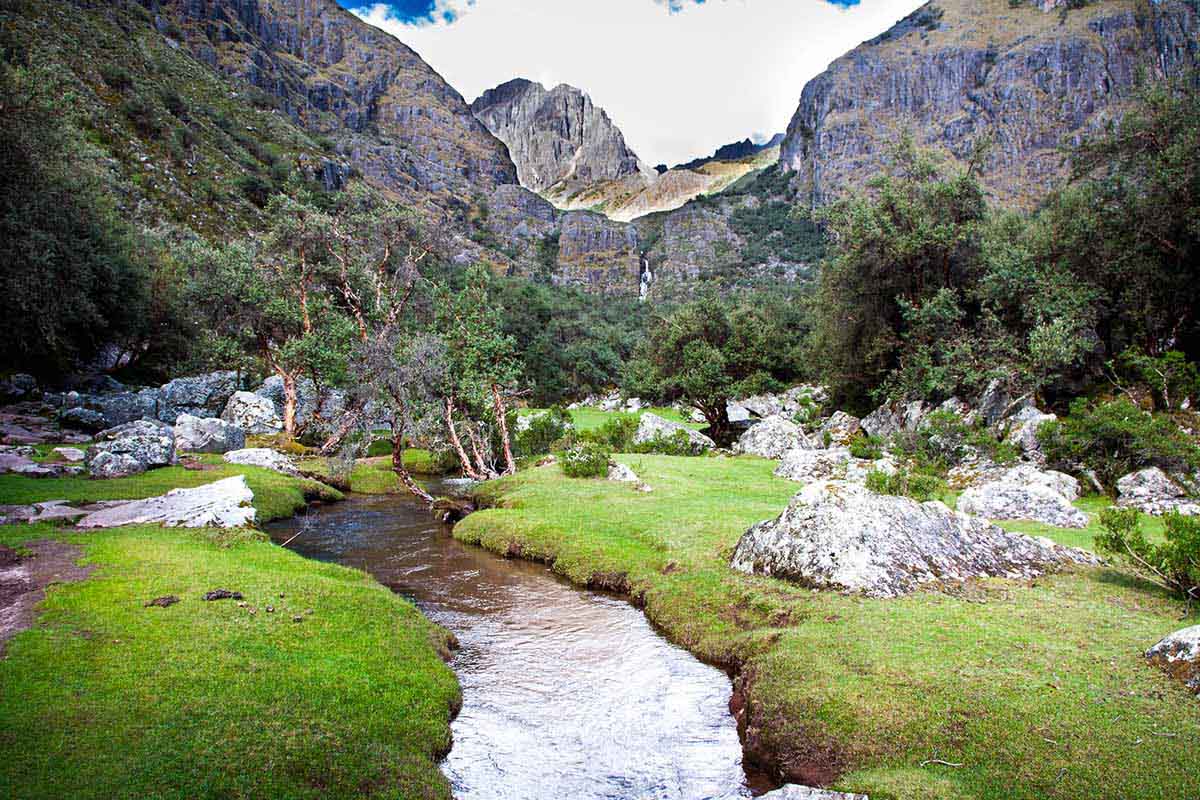
Approaching a lagoon along the Lares trail. Photo by Matthew Barker of Peru for Less.
The Lares trail begins in Calca, a small village in the picturesque Sacred Valley. The trail passes through Andean villages where the locals continue in the traditions of their ancestors, farming high elevation produce and weaving remarkable textiles. Close to the village of Lares, trekkers can head to the hot springs for some well-deserved rest. In the afternoon, descend to Huacahuasi to camp.
Passing by herds of alpacas and llamas , ascend gradually to the Ipsayccasa pass, reaching the highest elevation along the trek. Views of snow-capped Mount Veronica and the surrounding peaks are remarkable. Descending to the Ipsaycocha Lake, break for lunch before continuing the descent to the town of Patacancha. A traditional Quechua village, trekkers are invited to experience their way of life before continuing on to their campsite Pumamarka, resting between two mountains.
From Pumamarka, begin the descent to Ollantaytambo, passing small archaeological sites along the way. After lunch in Ollantaytambo, catch an afternoon train to Aguas Calientes. Sitting just below Machu Picchu, trekkers can shower and rest in their Machu Picchu hotel for the night.
Finally, wake up early to head to the citadel of Machu Picchu. Take on the challenge of hiking either Machu Picchu Mountain or Huayna Picchu: two hikes within the citadel offering impressive aerial views. Following the hike, tour the sanctuary with your guide before departing the city by train.
Permits to hike Machu Picchu Mountain and Huayna Picchu are limited and must be secured in advance.

Crossing a river on the Lares Trek. Photo by Paulo Philippidis on Flickr.
This combination trek is the only multi-day Inca Trail alternative that enters Machu Picchu through the Sun Gate. After passing through the Andean villages of the Lares Valley for the first two days, hike the last leg of the Inca Trail hike, leading to the mysterious ancient Inca citadel Machu Picchu .
Trekking Tours:
| Lares + 2-day Inca Trail | Inca Trail | |
| Duration and distance | 4 days, 28 miles | 4 days, 30 miles |
| Advance permit required | Yes, 2-day Inca Trail permit must be secured in advance. However, the portion of the Lares Trek does not require a permit. | Yes, 4-day Inca Trail permit must be secured in advance |
| Arriving to Machu Picchu | On foot through the Sun Gate | On foot through the Sun Gate |
| Nights camping or in hotels | 2 nights camping, 1 night in a hotel | All 3 nights camping |
| Porters | Pack animals on days 1 & 2. No pack animals allowed on the Inca Trail. | Personal porters can be hired ahead of time. No pack animals are allowed on the Inca Trail. |
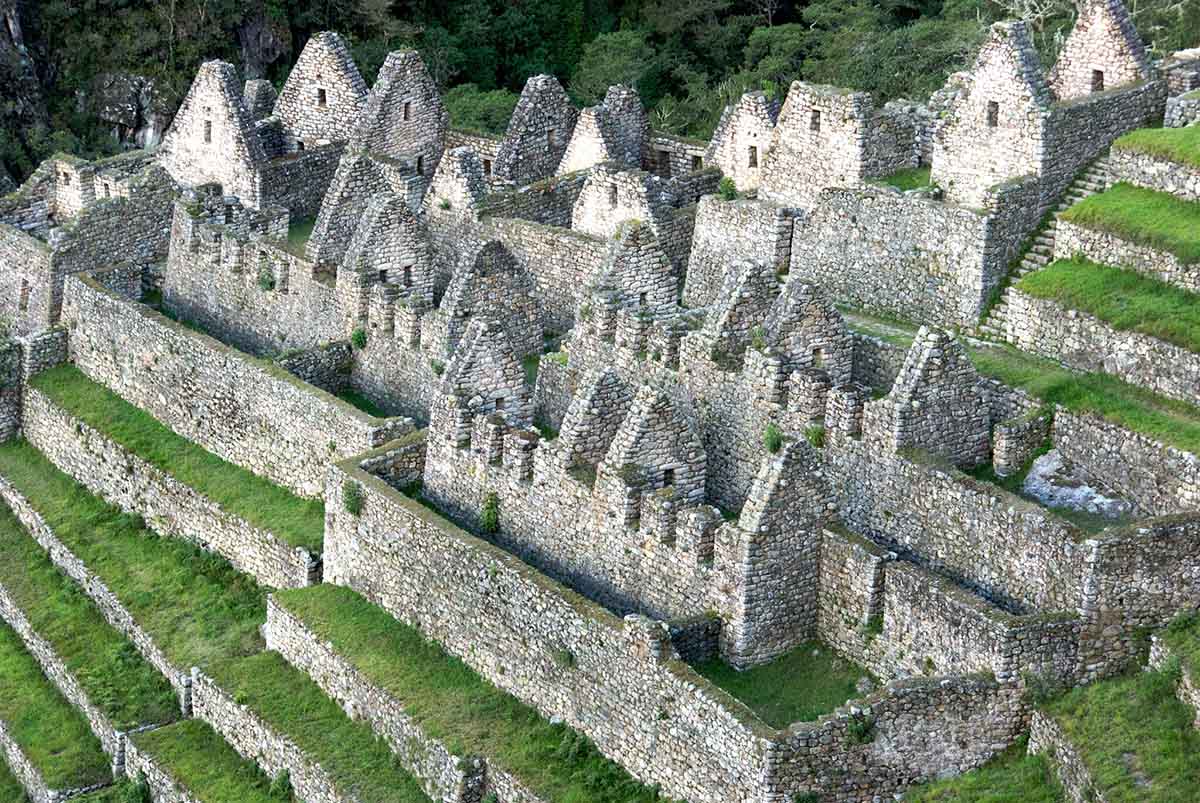
Winay Wayna ruins along the 2-day Inca Trail. Photo by Kevin Jones on Flickr.
Like the 4-day Lares trek, this hike explores the small towns of the Lares Valley. Beginning in Huacawasi, travelers can learn about the town’s customs before beginning the ascent up to the highest pass, Ipsayccasa. See striking views of Mount Veronica and the surrounding peaks before descending to Ipsaycocha Lake for the night.
Wake up early to descend to the Patacancha community, characterized by colorful textiles and traditional Quechua culture . A visit to the Pumamarka archaeological site follows, along with several smaller sites en route to Ollantaytambo.
Head to the Ollantaytambo train station this morning to board the train to Km 104. Getting off the train at Km 104, check in to the two-day Inca Trail path to begin hiking to Machu Picchu.
While hiking the Inca Trail to Machu Picchu, trekkers will pass by two archaeological sites. Chachabamba and Wiñay Wayna are remarkable sites on the way to Inti Punku , the Sun Gate. Take some photos of Machu Picchu in the afternoon light before heading down to town for a restful stay in a Machu Picchu hotel .
The final day of the trek returns to Machu Picchu by bus for a morning guided tour of the sanctuary. After exploring the citadel thoroughly, head to the train station for an afternoon train back to Cusco.
Optional: Hike Machu Picchu Mountain or Huayna Picchu on this final day. Permits are limited and must be secured in advance.
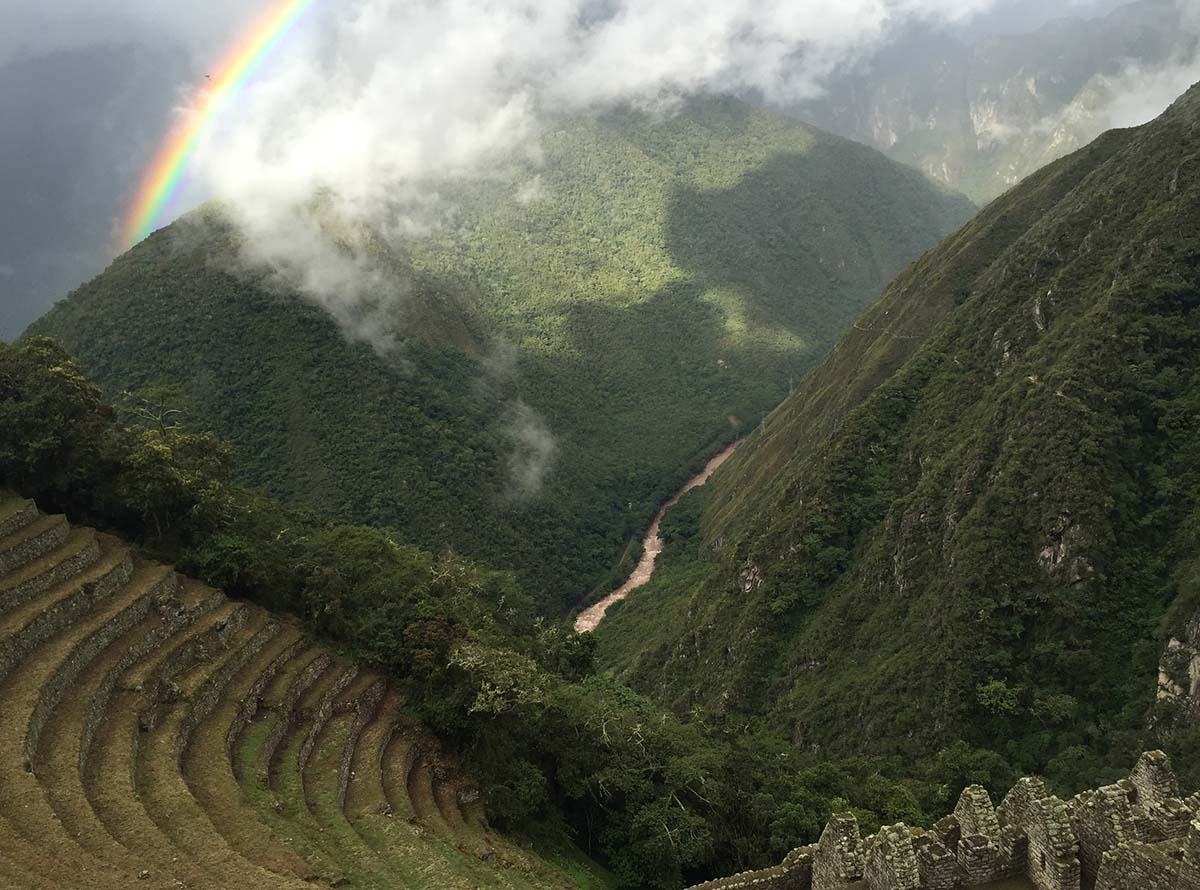
Hiking along the 2-day Inca Trail. Photo by Shriram Rajagopalan on Flickr.
The Choquequirao Trek is considered one of the most challenging Inca trails in Peru. While the trek is difficult, the extra effort makes your experience of the ancient Inca citadel that much more rewarding.
The most common itinerary is 8 days and 7 nights. The trail takes travelers through the Rio Blanco Valley into the high elevations of the sacred mountain passes. Trekkers will have the opportunity to visit ruins rarely seen by travelers and experience the diversity in ecosystems for which the region is known. From high elevation tundras and lush river valleys to sub tropical cloud forests, this Inca Trail alternative trek will show you the dramatic contrasts of the Inca heartland.
| Choquequirao Trek | Inca Trail | |
| Duration and distance | 8 days, 62 miles | 4 days, 30 miles |
| Advance permit required | No | Yes, 4-day Inca Trail permit must be secured in advance |
| Arriving to Machu Picchu | By bus to the main entrance | On foot through the Sun Gate |
| Nights camping or in hotels | 6 nights camping, 1 night in a hotel | All 3 nights camping |
| Porters | Pack animals can help carry personal belongings through Day 7. | Personal porters can be hired ahead of time. No pack animals are allowed on the Inca Trail. |
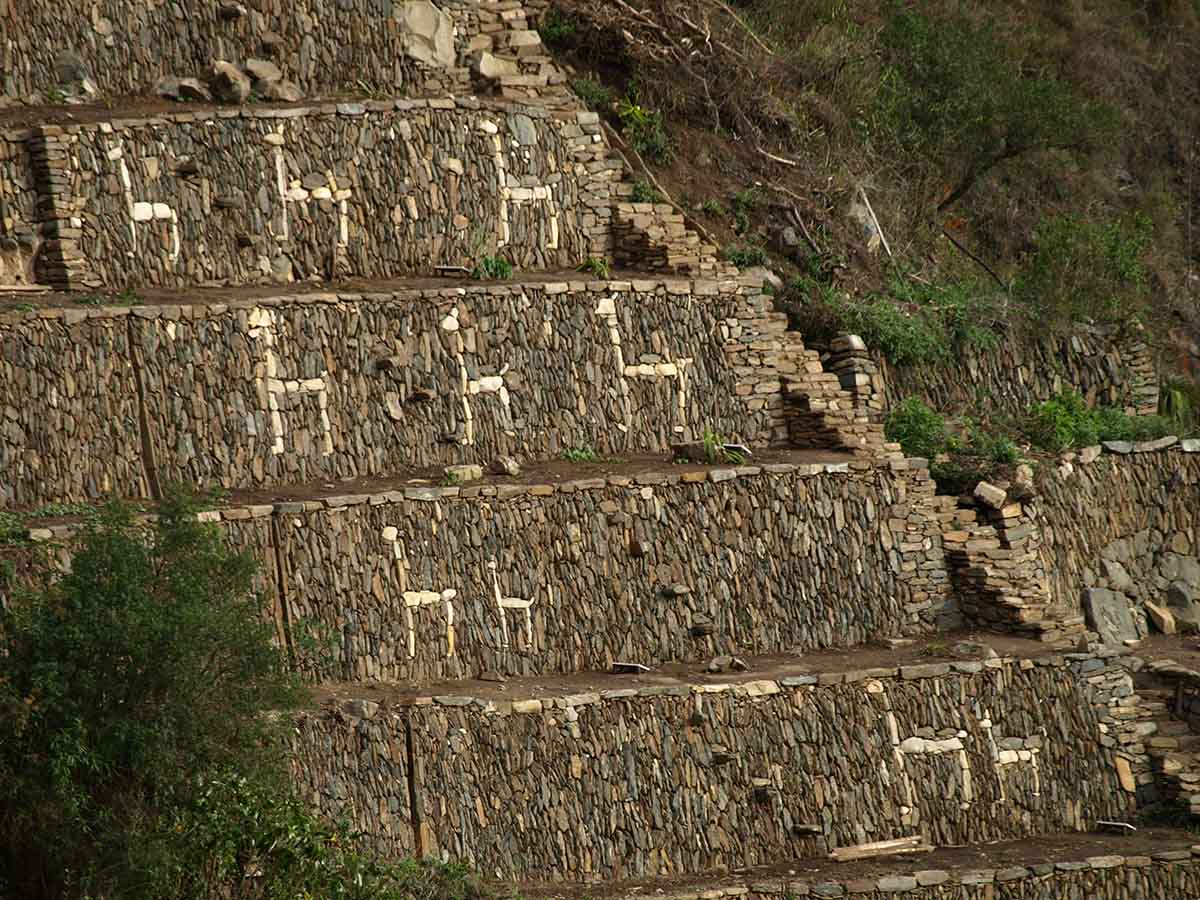
Llama shapes in the stone walls of Choquequirao ruins. Photo by Matthew Barker of Peru for Less.
The trek begins in the small village of Cachora, which is about 3.5 hours by bus from Cusco. Walking along relatively flat terrain, trekkers get their first glimpse of the Apurimac Canyon and Apurimac River before spotting Choquequirao in the distance.
On the second day, trekkers will descend to the river valley and cross the Apurimac River via a hanging bridge. Ascend on a winding route before arriving at the archaeological site of Choquequirao to explore and camp.
Along the path, visitors will witness the gradual change in microclimates indicated by the variation in vegetation. It is likely that trekkers will see the famous Andean condor soaring overhead, as this region is their native land.
Wake up to continue exploring the nine distinct areas of Choquequirao. Upon the departure from Choquequirao, the trail winds through the lush Rio Blanco Valley, where trekkers can see the ancient agricultural terraces constructed and used by the indigenous people for centuries.
During the fourth day, walk through a cloud forest into the Andean highlands. With sites of the Vilcabamba mountain range in the distance, trekkers continue to Yanama, a small village surrounded by mountains.
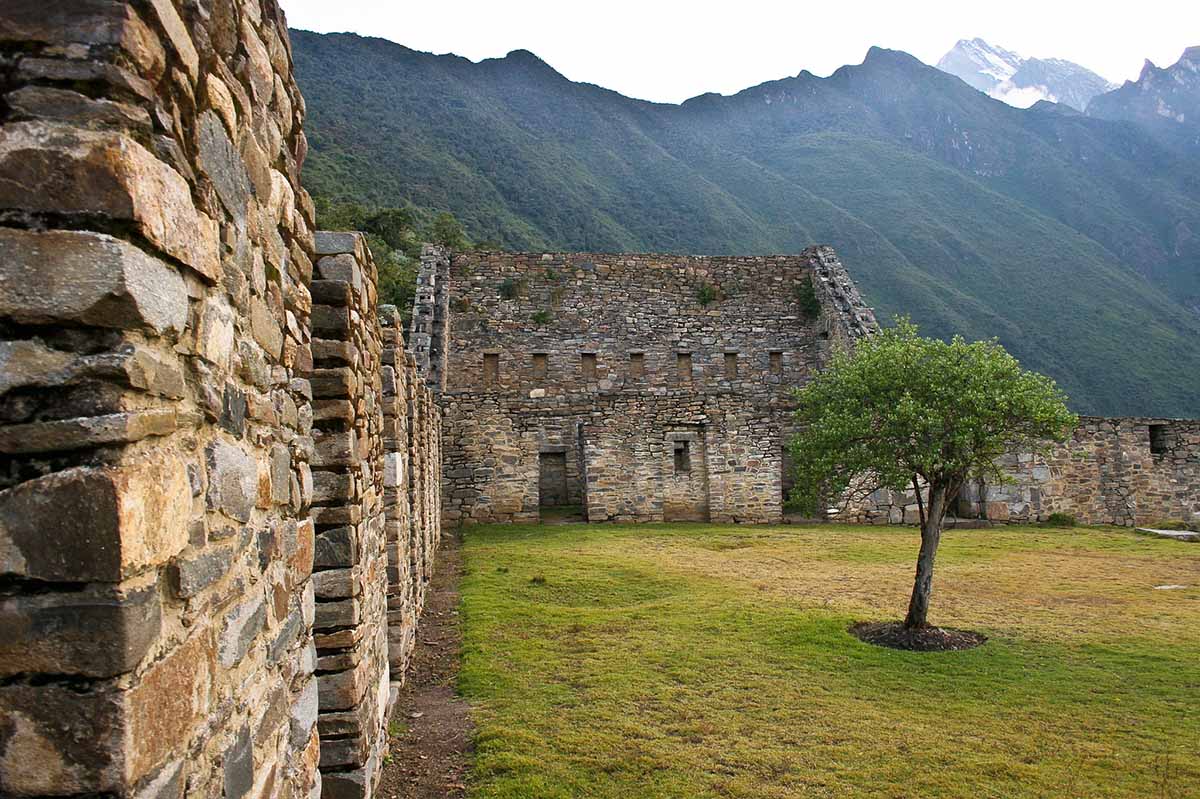
Inside Choquequirao ruins, Machu Picchu’s “sacred sister”. Photo by Matthew Barker of Peru for Less.
The fifth day is when the trail passes through the highest elevation of 15,355 feet (4,680 meters) above sea level. This is definitely the most difficult day of trekking, but travelers are rewarded with picturesque views of surrounding mountain peaks, like Salkantay and Pintuyo with their crests piercing the clouds.
Head down towards the village of Winaypocco with its subtropical flora and fauna, waterfalls, and tranquil natural baths. Visit the locals of this town to learn more about locally grown granadilla, coffee, and avocado.
Trekkers will continue the descent until reaching the Lucmabamba Valley. Heading upwards, trekkers are able to visit Llactapata, an archaeological site that overlooks Machu Picchu from afar. Heading back down, trekkers will continue on to Aguas Calientes by train, where they can relax and rest in a comfortable Machu Picchu hotel .
Head to the entrance of Machu Picchu this morning by bus. Tour the mystical site with your guide before beginning the Huayna Picchu or Machu Picchu Mountain hike for impressive aerial views. After spending the morning at Machu Picchu, head back to town for lunch and the train back to Cusco.
Permits to hike Machu Picchu Mountain and Huayna Picchu are limited and must be secured in advance.
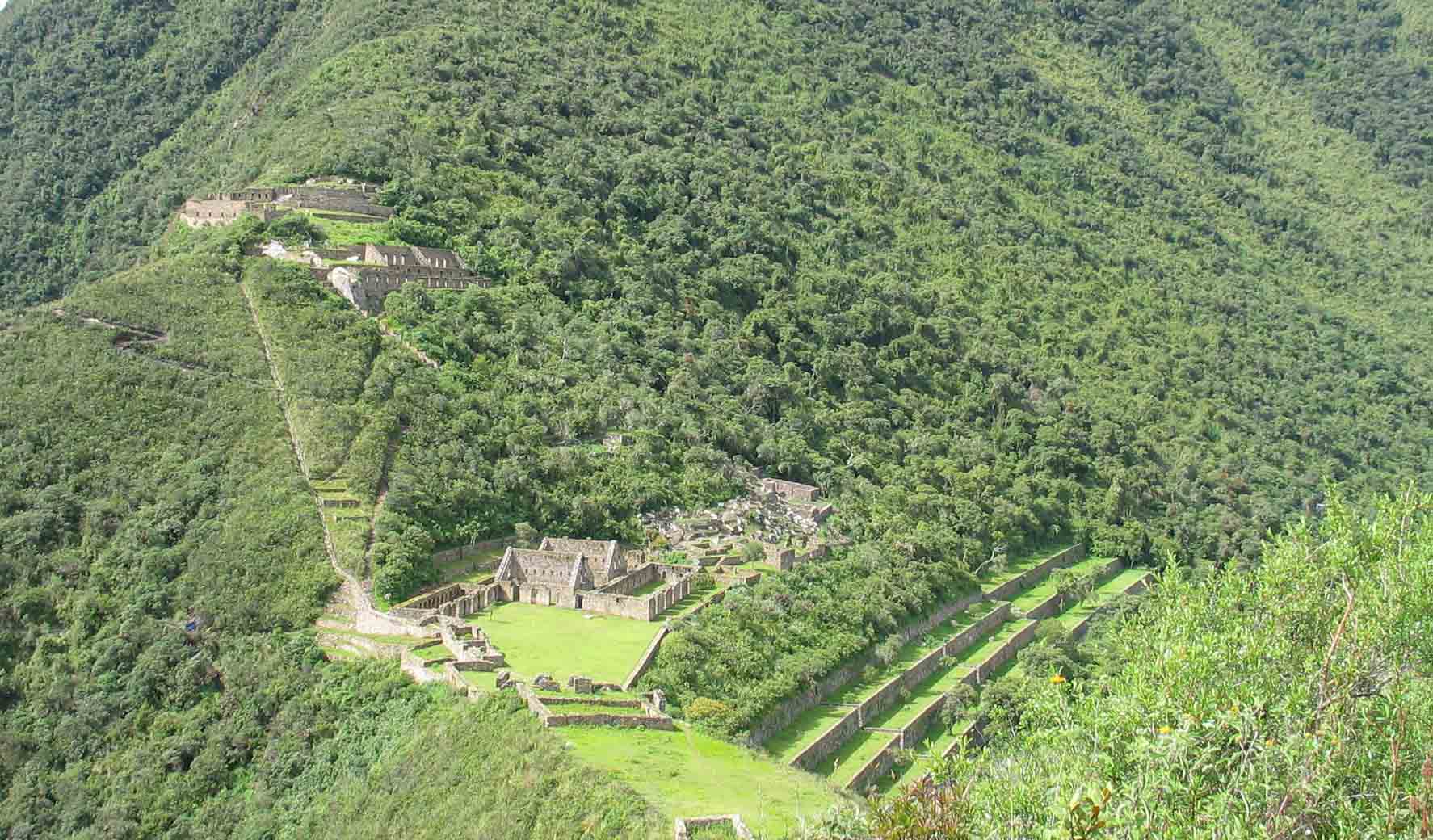
Approaching Choquequirao ruins on the Choquequirao trek. Photo by Bryan Dougherty on Flickr.
Also known as the jungle trek, the Vilcabamba Trek winds through lower cloud forests north of Machu Picchu. It is a trek unlike any other in the region, spanning the course of 5 days and 4 nights through the scenic Vilcabamba range.
| Vilcabamba Trek | Inca Trail | |
| Duration and distance | 5 days, 31 miles | 4 days, 30 miles |
| Advance permit required | No | Yes, 4-day Inca Trail permit must be secured in advance |
| Arriving to Machu Picchu | By bus to the main entrance | On foot through the Sun Gate |
| Nights camping or in hotels | 3 nights camping, 1 night in a hotel | All 3 nights camping |
| Porters | Pack animals can help carry personal belongings through Day 4. | Personal porters can be hired ahead of time. No pack animals are allowed on the Inca Trail. |
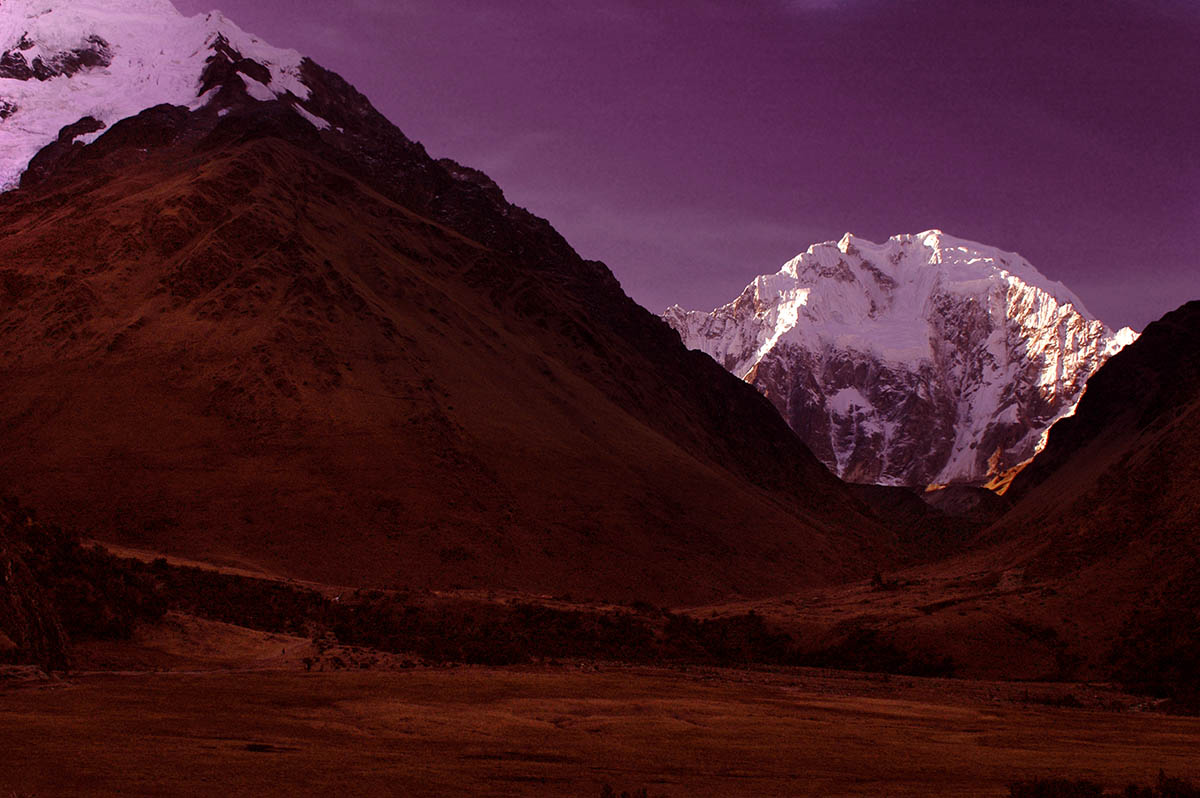
Hiking along the Vilcabamba trail.
The Vilcabamba trail starts in the remote village of Huancacalle, where Inca ruins lie relatively unvisited by tourists. One of the most unique is the White Rock, known as Yuraq Rumi , which is an unusually large carved stone probably used for religious purposes. Also in the area is Vitcos, a residence of the last Inca Emperor built in the 1500s.
Trekkers will continue along the ancient trail granting them exclusive opportunities to see the many subtropical vegetation, including naturally grown coffee and coca, which help to sustain the agrarian families living in the remote villages of the Vilcabamba mountain chain.
Winding their way towards Machu Picchu surrounded by snow-capped mountains, trekkers will experience some of the most breathtaking scenery of the cloud forests amid the tall Andean peaks.
Arriving in Aguas Calientes on the fourth day of the trek, travelers are able to rest in the comfort of a hotel , as well as relax in the thermal baths for which the town is famous.
On the fifth day, trekkers take a short bus ride to the entrance of Machu Picchu in order to explore the ancient citadel. This is truly a rewarding experience after 5 days of high elevation jungle trekking.
Optional: Hike Machu Picchu Mountain or Huayna Picchu on this final day. Permits are limited and must be secured in advance.
While the Ausangate Trek does not end in Machu Picchu, this impressive Inca Trail alternative trek through Andean mountains is truly off-the-beaten path. The Ausangate trek circles its namesake, the Ausangate Mountain sitting about 60 miles east of Machu Picchu. It is one of the most beautiful and sacred treks in Peru, but sees very little traffic.
The trek to Apu Ausangate , Quechua for Ausangate Mountain, offers spectacular views of the surrounding mountain range as well as a sacred mysticism which is celebrated by locals every year. The 6 day trek is most famous for the pilgrimage Qoryllur Riti , which takes place every year in June to honor the harvest season and indigenous heritage. For more details, check out our expansive guide to the Ausangate trek .
| Ausangate Trek | Inca Trail | |
| Duration and distance | 6 days, 41 miles | 4 days, 30 miles |
| Advance permit required | No | Yes, 4-day Inca Trail permit must be secured in advance |
| Arriving to Machu Picchu | Machu Picchu not a part of the trek | On foot through the Sun Gate |
| Nights camping or in hotels | All 5 nights camping | All 3 nights camping |
| Porters | Pack animals can help carry personal belongings throughout the trek. | Personal porters can be hired ahead of time. No pack animals are allowed on the Inca Trail. |
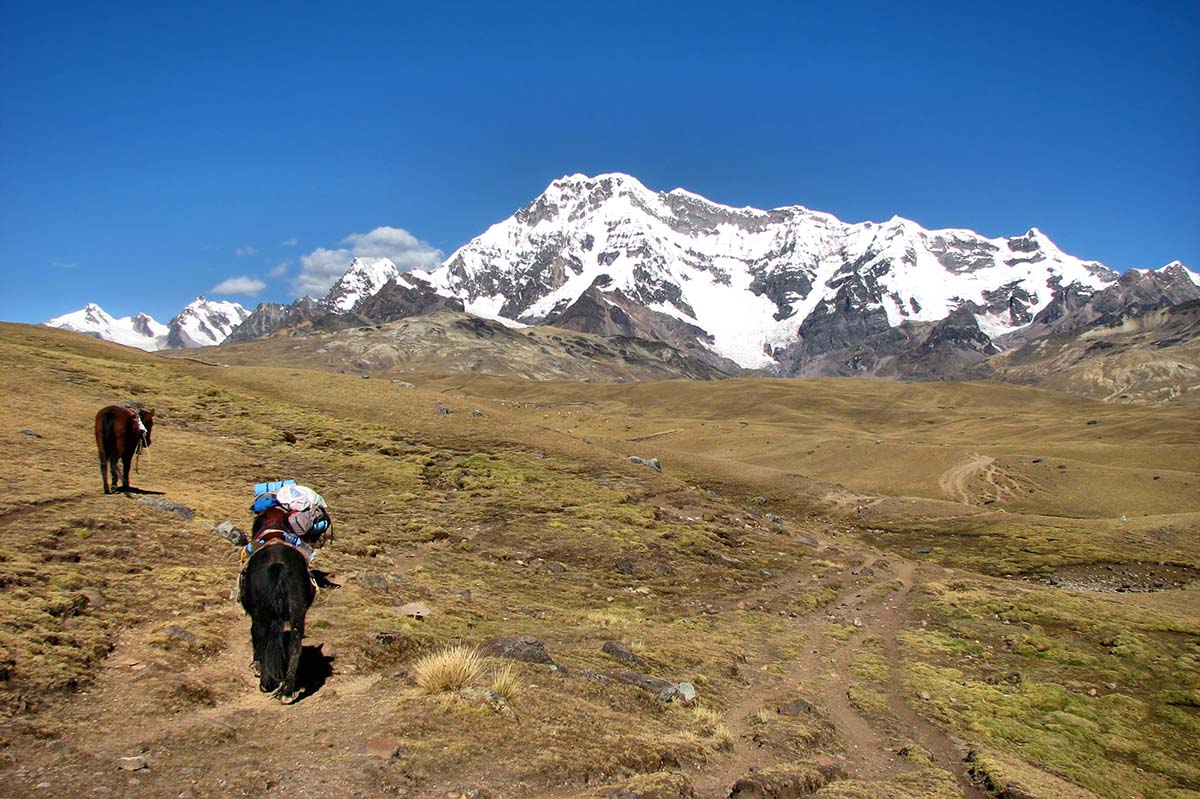
Hiking along the Ausangate trail.
From Cusco, head to the town of Tinki to begin the Ausangate trek. Trekkers will snake between the Andean mountains and pass through traditional, indigenous villages. Views of the Vilcanota mountain range and a panoramic view of Cusco itself are other highlights on the first day.
Passing by impressive mountain landscapes, arrive in Upis to explore the nearby area. Visit relaxing thermal lakes and mystical glaciers resting around Mount Ausangate for an unforgettable Andean experience.
Head towards the Arapa Pass for incredible views of Apu Ausangate and the surrounding mountain chain. Descend to the Red Lagoon, Pukacocha , a tranquil lake nestled between peaks, for the night.
Ascend to the second pass, Apacheta, overlooking the snowy peaks of the Vilcanota range. Head downhill, stopping for lunch, and then head up again to the highest elevation during the trek: Palomani Pass. Finally, descend towards the Qampa Valley to camp, with a chance to see condors , chinchillas, and vicuñas in their natural habitat.
Passing by massive glaciers and snow-covered mountains, trek towards Ticllacocha Lagoon and then the Qampa Pass. Head to camp on the shores of the Green Lake, Qomercocha .
On the sixth day, trekkers pass along a chain of clear, icy Andean lakes before crossing a meadow where alpacas and llamas graze. Just beyond the meadow, arrive at Pacchanta, a small village with hot springs. After relaxing tired muscles in the thermal baths, return to Cusco by car.
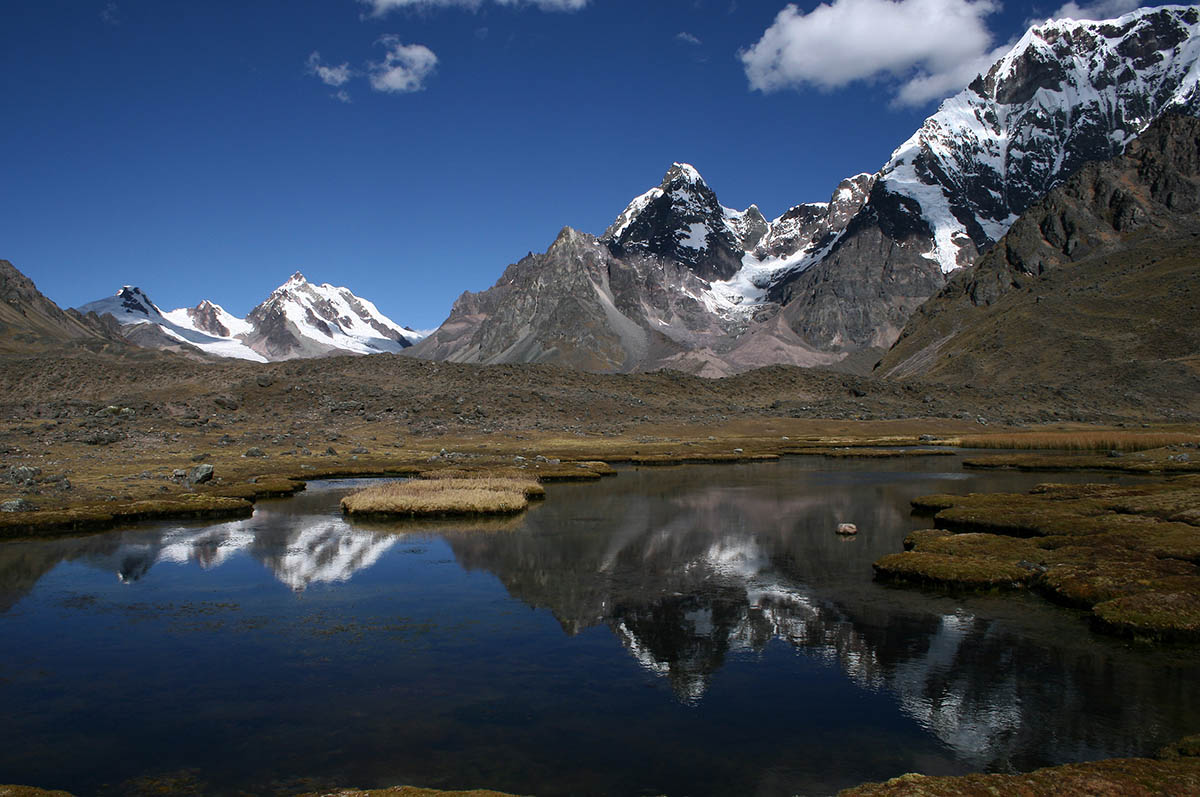
Andean lagoon along the Ausangate trek.
There are many great Inca Trail alternatives to trek in the Cusco region. If the Classic Inca Trail is sold out, rest assured that you will be able to visit Machu Picchu and hike in the region, much in the way the Incas did over five hundred years ago. Just make sure you are in good physical health and you are ready for a historical and cultural adventure! Contact our team of experts to begin planning your customized trekking trip to Peru .



Email: [email protected]
Sign up to receive our newsletter for great articles, stunning photos, and special deals.